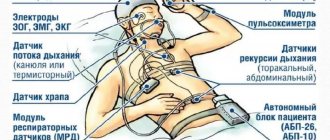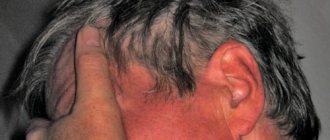Pain Treatment Center
Alekseeva
Oksana Alexandrovna
23 years of experience
Doctor, highest qualification category, member of the European Association of Neurologists, Russian Interregional Society for the Study of Pain (ROIB), Association of Interdisciplinary Medicine. Has experience working in hospital and outpatient services. He has seven published works on neurology.
Make an appointment
The term “neurosis” is usually used to designate a whole group of pathologies, which are based on temporary reversible mental disorders caused by excessive load on the basic nervous processes - excitation and inhibition. Neuroses are functional diseases that are not based on structural disorders. They arise as a result of a severe conflict within the individual or changes in particularly significant life relationships of a person and are manifested by exclusively mild neurotic symptoms and somato-vegetative deviations.
According to academician V.P. Pavlov, neurosis is a breakdown of higher nervous activity that occurs when the normal course of basic nervous processes, their relationships, strength and mobility changes. That is, this is a violation of higher nervous activity and neurovegetative functions, developing under the influence of mental trauma or prolonged emotional stress. It manifests itself primarily in the emotional sphere, while the state of affect provokes changes in thinking and general behavior.
This condition lasts from several days to several years. At the same time, the patient maintains a critical attitude towards the disease, there are no violations of social adaptation. People with melancholic and choleric types of temperament are more likely to suffer from neuroses, while sanguine and phlegmatic people suffer from them much less often.
A characteristic feature of all neuroses is the fact that a person is often aware of the meaninglessness of his symptoms (panic, fear, etc.) or the absence of grounds for somatic symptoms, but still feels anxiety associated with them. It is the patient's criticism of his symptoms that distinguishes neuroses from psychoses.
It should be noted that in the 10th edition of the International Classification of Diseases (ICD-10), the word “neurosis” is not used, and the dominant symptomatology became the basis for the classification of the corresponding group of mental diseases. Thus, some traditionally neurotic disorders belong to “eating disorders”, others to “sleep disorders of an inorganic nature”, etc.
But, despite the fact that the concept itself is gradually disappearing from the terminology of clinical diagnostics, it still remains widely used in psychological practice and the theoretical works of many authors. The concept of neurosis is still useful today when constructing a strategy for psychological support in the psychological service system.
The concept of neurosis unites a whole group of mental disorders with very different symptoms from all organs and systems. This includes a set of psychogenic, emotional and physiological disorders.
Symptoms and signs
Neuroses are characterized by dynamic and varied psychopathological and somatic symptoms against the background of insufficient mental defense. This is accompanied by the formation of a conflict, manifested by disturbances in different areas (emotional, vegetative, endocrine, etc.). There are main groups of clinical symptoms inherent in all types of neuroses, this includes disorders from:
1. self-control:
- discomfort;
- headache;
- feeling of weakness (especially after sleep);
- increased fatigue;
- decreased ability to work;
- prostration.
2. emotions:
- changeability (lability) of mood, irritability;
- tendency to depressive reactions, fears, obsessive concerns;
- violent affective outbursts followed by exhaustion;
- inadequacy of the emotional reaction to the strength of the stimulus;
- lack of control over emotions.
3. volitional sphere and drives:
- loss of appetite;
- sexual function;
- obsessive urges and actions;
- insufficient control of behavior.
4. somatovegetative system:
- hyperhidrosis (excessive sweating), hot flashes;
- increased dermographism (change in skin color, rash);
- tachycardia (rapid heartbeat), changes in blood pressure and pulse;
- constipation, nausea;
- frequent urination, enuresis;
- stuttering;
- tremor (shaking) of the body.
With each type of neurosis, especially its manifestation (vivid manifestation), an arbitrary number of the above symptoms may occur. In the process of further development of the disease, depending on personal characteristics, violations of mental or somatovegetative functions come to the fore.
The development of a certain type of disease significantly depends on the type of higher nervous activity (HNA). Individuals with an artistic type, in whom the first signaling system (subcortical processes) dominates the second (cerebral cortex), often experience hysterical neurosis. Individuals with the mental type GND are prone to obsessive-compulsive neuroses when the second signaling system prevails over the first. Most people have a mixed type of GND; most often they experience neurasthenia.
Are you experiencing symptoms of neurosis?
Only a doctor can accurately diagnose the disease. Don't delay your consultation - call
Neurosis
Neurosis is a collective name for a group of functional psychogenic reversible disorders that tend to be protracted. The clinical picture of such disorders is characterized by asthenic, obsessive and/or hysterical manifestations, as well as a temporary decrease in mental and physical performance.
The fact that such neurosis has become known since 1776, thanks to the research of the Scottish physician William Cullen. A more detailed study of this disease and its types was carried out by the Russian scientist I.P. Pavlov.
There are four main types of neuroses:
- Depressive. Characteristic signs of a decadent mood and inhibition of intellectual development.
- Hysterical neurosis is caused by a person’s low self-esteem among others. There is a feeling of lack of attention, which leads to pretentious behavior and a complete reassessment of the personality. Hysterical neurosis often begins in childhood.
- Asthenic or neurasthenia. Characteristic factors of the disease: fatigue, mood instability and a state of complete depression. Anxious. The name says that this disease is based on the appearance of factors of fear, increased anxiety, and depression.
- Bulimic neurosis. Refers to mental disorders and is characterized by the manifestation of uncontrollable eating of high-calorie foods. Bulimic neurosis is more common among men (about 60%), less common among women.
Causes of neuroses.
The main factors in the emergence of a disease based on mental disorders include physical and psychological influences.
1. Heavy loads on the brain or serious emotional experiences. Mental stress is typical for children, and reasons such as unwanted dismissal, divorce, dissatisfaction with life are typical for adults.
2. Lack of ability to solve various problems. The main cause of mental disorder is considered to be various types of pressure from other people. For example, loans of money that eventually need to be repaid, but when they are not there, there is nothing to repay. In such a situation, the person who borrowed begins to put pressure on the borrower in every possible way, which causes the occurrence of a neurotic disorder in the second one.
3. Characteristic signs of forgetfulness, which ultimately lead to serious consequences (death of people, damage to property, illness). These consequences settle in a person’s soul and do not provide the opportunity for a normal existence. A state of self-blame and doubt arises.
4. Deviations in the development of the central nervous system come down to the fact that a person is incapable of prolonged physical and mental stress. These reasons contribute to the development of asthenic neurosis.
5. Diseases through which complete or partial depletion of the body occurs. Typical diseases of this kind are tuberculosis, influenza, etc. An important reason that tends to provoke neuroses is a person’s addiction to alcohol, tobacco products or narcotic substances.
Currently, neuroses have entered everyday human life unnoticed, and it is almost difficult to say how many people do not know this disease. For some people, this disorder is considered a normal condition, but for others it is suffering, the way out of which a person finds not in medications, but in alcohol, religion, and work. Thus, trying to get away from the main primary sources of mental disorders. There is an opinion that neuroses are protective factors of the brain, providing protection from adverse social and psychological influences. These influences include: aggressive attitude of parents towards the child or, conversely, too much care, isolation or humiliation, neglect. A genetic predisposition cannot be ruled out, which may ultimately manifest itself both in older age and in children. When a child’s parents allow everything, he gets used to it, and when he enters kindergarten or school, the attitude of his peers and teachers towards him will be correspondingly different. In this case, conflict situations arise in children, which primarily affects the child’s psyche. From this it turns out that even from an early age, the cause of subsequent neurosis in children develops. Thus, the psychological reasons for provoking neurosis include: features of educational methods; the level of parents' aspirations for the child; human relationships in the social sphere; characteristics of personality development. The biological causes that cause neuroses are characterized by: functional failure; deviations due to congenital pathologies; physical injuries; injuries in women during difficult childbirth or through abortion. Clinical picture
Symptoms of the disease are divided into two forms of manifestation: somatic and mental.
Somatic symptoms of neurosis are characterized by the manifestation of pain, such as: 1. The occurrence of headaches, which are characterized by duration and suddenness of appearance. Pain in the heart and abdomen, muscles and joints, which is the root cause of the malaise. Also characteristic is the appearance of hand tremors and frequent urination, not necessarily supported by diseases of the kidneys and genital organs. 2. It is common for a person to get tired quickly, even if he has not done anything. At the same time, fatigue is both physical and mental. There is no desire to do any work, and there is a decrease in performance. A person with symptoms of neurosis becomes sleepy and gloomy.
3. Darkening in the eyes, disorientation in the area, dizziness and even fainting - all these are symptoms of the disease.
4. It is common for a person to experience sweating, which is characterized by the frequency of its occurrence. This sweating does not arise from hot weather, but from constant fear, anxiety, and nervousness. Sweat is especially active at night, when a person sleeps and discovers a damp pillow the next morning.
5. Mental disorders affect the decrease in potency and can ultimately develop a disease such as prostatitis.
6. The vestibular apparatus is disrupted. Signs of this disorder are frequent dizziness, especially when tilting the head back. These dizziness are rare in the initial stages, but as the disease progresses they intensify and cause discomfort when performing physical work.
7. Dietary disorder. The psychological appearance causes a disturbance of appetite in a person, and this can be either undernutrition or overeating. Overeating or excessive consumption of fatty foods indicates that a person has bulimic neurosis. Against the background of mental disorders, a person finds solace in eating food, which causes another problem - obesity. Frequent meals also do not solve the problem of neurosis, so therapeutic measures will be required.
8. The occurrence of insomnia or a constant desire to sleep. Depending on the person and the reason for provoking neurosis, one or another symptom may be inherent. During sleep there are frequent awakenings caused by nightmares.
9. Health problems that affect the human psyche. He worries about his health, about what to do next, what to do.
Mental symptoms of the disease:
- Emotional stress that arises due to the absence of visible reasons.
- The reaction to stressful situations in patients with neurosis manifests itself in the form of isolation and fixation on one thing. A person constantly worries about something, thinks, but does nothing useful. Often, “withdrawal” can cause phobias, which must be suppressed through treatment.
- Symptoms of the disease manifest themselves in the form of weakened memory, a person becomes forgetful, and complains of a variety of thoughts in his head.
- Sensitivity of the body to sudden changes in temperature. Bright lights and loud sounds also cause pain. The patient wants privacy and silence.
- Inferiority complex in communication. A patient with neurosis can be characterized by either high self-esteem or low self-esteem.
- Symptoms of the disease are also characterized by uncertainty and inconsistency. It is common for people to incorrectly define preferences and set household priorities.
- A person becomes irritable over trifles, difficult to predict and sensitive to little things addressed to him.
All these symptoms can develop into chronic malaise, and this is a more complex form of neurosis.
Diagnosis of neuroses
Diagnosing neuroses involves a correct assessment of symptoms. First of all, it is necessary to exclude other diseases that have similar somatic symptoms to neuroses. These are diseases of human internal organs. Diagnosis of neurosis is quite difficult due to the lack of objective and practical indicators that would describe the picture of the disease. The doctor cannot prescribe tests, since neuroses cannot be diagnosed through examinations using special medical equipment. The disease is diagnosed using a color technique. All colors take part in the technique, and a neurosis-like syndrome manifests itself when choosing and repeating purple, gray, black and brown colors. Hysterical neurosis is characterized by the choice of only two colors: red and purple, which 99% indicates the patient’s low self-esteem.
Treatment of neuroses
Treatment of neuroses through psychotherapy involves influencing the patient’s psyche, persuading him, and realizing reality. It is also necessary to identify the root cause of the development of the disease, and if it is embedded in the genes or originates from early childhood, then treatment through psychotherapy alone will be ineffective and will not bring the desired result.
Drug treatment involves taking appropriate medications (antidepressants, anxiolytics, tranquilizers, antipsychotics), the action of which is aimed at restoring processes occurring in the brain. The principle of the influence of drugs is based on a calming effect on the central nervous system, resulting in a decrease in the symptoms of the disease.
Treatment of neurosis at home is of no small importance.
Treatment of neurosis at home is the most common method, since this disease requires a revision of one’s thoughts and a way out of this state. The first home treatment is to engage in sports. It doesn’t matter what sport (gymnastics, running) you choose, the main thing is to start developing physically. Treatment of neurosis at home through physical exercise has a positive effect on the heart and the body as a whole, enriching it with fresh oxygen. You should devote no more than 15 minutes a day to exercise and within a week the results will be noticeable. At home, treatment of acute and chronic neuroses is carried out through proper nutrition, which includes vitamins and minerals that stimulate brain function. Color therapy treatment involves wearing clothes exclusively in warm and light colors. You can relieve tension by looking at pictures or walking through a green garden, from which you will get a double effect - both relaxation and enrichment with fresh oxygen. At home, treatment of acute neuroses can be carried out using music therapy. To calm you down, select an appropriate melody or song that you should listen to for 30 minutes every day (preferably before bed). Give yourself the opportunity to rest more and not think about bad things, not worry about trifles and not take various grievances to heart.
Neurasthenia
It is characterized by the presence of diverse symptoms: somatic, neurological, psychopathological. Somatic symptoms are not associated with any disease of the internal organs, but are often so pronounced that they force the patient to constantly contact the appropriate doctors. Mainly observed manifestations of dysfunction of the cardiovascular system, tachycardia, sometimes slowing of the pulse, a feeling of pain, freezing or compression in the heart area. Sometimes there is dysfunction of the digestive tract: decreased or “crankiness” of appetite, nausea, upset stool. With neurasthenia, the symptoms of neurosis in women are expressed by abnormalities in the menstrual cycle. Neuroses in men are characterized by signs of impotence (various forms of impaired sexual desire and erection).
Common symptoms include hyperesthesia (increased sensitivity) to external stimuli (light, sound, etc.), poor health, which is difficult for patients to describe. There is a feeling of heaviness in the head (“cloudy head”), headache of undetermined localization, and dizziness. There are problems with sleep: falling asleep takes a long time, frequent awakenings, sleep is not deep enough, which means it does not bring pleasure and a feeling of rest, even if its duration is sufficient.
The neurological status shows increased tendon reflexes, tremor of extended limbs, severe sweating and other signs of irritation of the autonomic nervous system.
The psychopathological symptoms of neurasthenia are well described by the term “irritable weakness” - increased excitability is combined with rapid fatigue. A bad mood and emotional lability are inherent, which, unlike that in hysteria, is accompanied by rapid depletion of nervous processes. Emotional “explosions” begin easily, due to an insignificant reason. After them, the patient begins to repent of his behavior and feel awkward. Tearfulness is typical, even for neuroses in men, and imbalance when communicating with others. Working capacity, in particular mental, is reduced, but often a person, under the influence of tonic mental factors, can “pull himself together” and complete the required amount of work.
With neurasthenia there are no qualitative intellectual impairments. Patients complain of forgetfulness, poor memory in everyday life, and worry about this. Such manifestations are the consequences of impaired attention and poor concentration, but they pass without a trace.
There are two forms of neurasthenia: hypersthenic and hyposthenic. Hypersthenic is characterized by a predominance of symptoms of irritable weakness, and hyposthenic is characterized by asthenia of the nervous system (general weakness, lethargy, intolerance to any irritants and stress, decreased vitality).
What is neurosis
The term neurosis emerged in the 18th century and was used to refer to a number of psychological disorders not associated with physical problems. Neuroses have now become confused with personality traits that are usually labeled neuroticism.
Today there is no clear and uniform definition of neurosis. To date, neurosis has been diagnosed as a psychological disorder that affects a person’s quality of life. At the same time, the disease does not interfere with a person’s perception of reality.
Since there is no single definition, some psychologists and psychiatrists use this term to refer to anxiety states, others use it to define behavior, and still others use it to describe the spectrum of mental illnesses. Followers of classical medicine use it to identify psychological problems. Psychoanalysts Sigmund Freud and Carl Jung used this term to describe the thought process.
In some countries, for example, in the United States, to avoid confusion in diagnosis, this term was removed (DSM-III).
Possible reasons
There are a huge number of reasons for the development of a psychoneurotic situation. This may be prolonged emotional or physical stress without a period of recuperation, chronic fatigue, stress, excessive dedication to work (without vacation or proper rest) or the presence of ailments. The institution will accurately determine the source of the pathological condition, which will help achieve the desired therapeutic effect.
William Cullen, who first used the term in 1769, argued that it referred to disorders of the senses and movements caused by damage to the nervous system. Here he included comatose states and epilepsy.
Sigmund Freud (1856-1939), the founder of psychoanalysis, believed that neurosis was caused by unsuccessfully repressed negative emotions from the past. Which speaks specifically about a psychological problem. These emotions suppress today's reactions. Freud gave an example of an uncontrollable fear of dogs that could result from a dog attack at an earlier age.
Carl Gustav Jung (1875-1961), Swiss psychiatrist, founder of analytical psychology. He believed that neurosis is a conflict between the conscious and unconscious.
Hans Jürgen Eysenck (1916–1997), a German-British psychologist, defined neurosis as emotional instability.
Why treatment of neuroses is often not effective
These definitions of neurosis confirm that it is understood by all specialists as a disease, but is defined by different specialists for different reasons. Accordingly, various treatments for neuroses are used; naturally, the effectiveness cannot be stable.
That is why some countries have removed this term from use. However, in Russia it still exists and is actively used. That is why it should be considered not as a separate disease, but as a set of symptoms that is included in any disorder of higher nervous activity.
To effectively cure neuroses, we first determine the true causes of the manifestation of this symptom complex, the individual characteristics of the formation of the body, and the presence of associated problems. To do this, we use advanced diagnostic techniques. Only after this we remove the cause, which helps relieve symptoms and leads to recovery.
Obsessive-compulsive disorders (OCD)
They are demonstrated by a feeling of fearfulness, intimidation, and anxiety. Obsessive thoughts haunt the patient against his wishes and will, although they are assessed by him as meaningless and harmful. There are syndromes of the following obsessive states:
- doubts – uncertainty about the correctness of actions taken or not taken, contrary to logical arguments. Such a person doubts whether he turned off electrical appliances, closed the door, whether the document was written correctly, etc., although he has repeatedly checked the action performed;
- Memories are annoying pictures of the past. Often a sad, unpleasant or shameful incident for the patient, and he tries not to think about it;
- imagination - the emergence of implausible images, perceived as real despite their absurdity. There may be a belief that the buried relative was alive, or other similar misconceptions. In this case, the patient imagines and painfully experiences the suffering of the “obviously dead” person in the grave or other unpleasant feelings;
- drive - a desire to carry out some extremely undesirable action, accompanied by horror and panic due to the impossibility of freeing oneself from such a desire. For example, it covers the desire to harm a loved one, throw yourself under a train, a car, or push someone under it. At the same time, an unbearable fear is experienced that this is happening (contrasting attraction);
- phobias (fears) - an unreasonable fear of heights, open or confined spaces, crowds of people, sudden death, etc. Sometimes they are accompanied by rituals - monotonous actions that have the meaning of spells and amulets. Such actions are performed with the aim of protecting against a certain misfortune, despite the critical attitude towards them. So, by walking around the arch, instead of passing under it, a person seems to be saving his relatives from harm; when starting something, he snaps his fingers twice or says the “cherished” word out loud - in order to avoid failure.
Some obsessive actions fill the patient’s thoughts until they are implemented, others pass and are forgotten. To keep himself from becoming obsessed, he needs to constantly monitor himself, which is extremely tiring for him.
Close to obsessional neurosis in clinical terms are psychasthenia and psychasthenic neurosis. They are characterized by:
- predominance of asthenia (enduring fatigue, weakness);
- constant general feeling of tension with heavy foreboding;
- conviction of personal social inadequacy, ugliness and inferiority relative to others;
- excessive impressionability due to criticism addressed to oneself;
- reluctance to make contact without a guarantee of being liked;
- avoidance of social or professional activities associated with significant social contacts due to fear of criticism, disapproval, or ignorance;
- limited life and social way of life due to the need for physical and psychological safety.
Differential diagnosis is necessary to distinguish obsessional neurosis from schizophrenia, cerebral atherosclerosis, and the consequences of encephalitis. The distinctive feature of neurosis, and at the initial stage the only psychopathological symptom, will be obsession. There are no intellectual disorders. If the disease takes a long course and is not sufficiently treatable, it can affect the patient’s personality and his future fate.
Hysterical neurosis
The clinical picture of hysteria is characterized by increased lability of emotions and the transition of the mental component to the somatoneurological one. This is the only form of neurosis when qualitative changes in consciousness are possible. Almost all symptoms of hysteria are protective for the patient, corresponding to a specific psychotraumatic situation. They bring a certain moral benefit to the individual, since they provide an opportunity to get rid of another difficult experience. Therefore, hysteria can be considered as a kind of protective phenomenon that occurs under the influence of a super-powerful stimulus.
Example: a mother received unexpected news about the tragic death of her son; while waiting for the body to be brought, she thought with horror that she would not be able to see him dead, and suddenly became blind; After a while, the hysterical blindness passed.
Emotional lability during hysteria manifests itself in a sharp change in emotions and their inconstancy. But, unlike neurasthenia, they are indicated by high intensity and duration. The patient, who a minute ago was crying bitterly and in deep despair, without much effort not only calms down, but also easily comes into a good mood. Such lability of emotions leads to instability in desires, intentions, behavior, likes and dislikes. In addition to emotional lability, a clear symptom of hysteria is easy suggestibility - both self-suggestion and the ability to be suggested by others.
The most striking reaction to a stimulus from the motor system will be a hysterical attack. Seizures do not occur when no one is near the patient, and are not accompanied by a sharp fall with bruises and injuries. Movement disorders have a pronounced neurotic character and coincide with the content of the patient’s experiences. He falls, chaotically swings his arms and legs, hits them on the floor, bends over, shouts out individual words. The seizure lasts from several minutes to hours. Unlike epileptic paroxysm, hysterical paroxysm is not accompanied by a clear violation of muscle tone, spasm of the sphincters with their relaxation and incontinence of urine and feces, the reaction of the pupils to light is preserved, and treatment is perceived adequately. After the attack, only a vague memory of it remains.
One type of hysteria is a disorder of consciousness under the influence of mental trauma. The perception of the surrounding reality is distorted. Behavior takes on childlike features, helplessness, and elements of fake dementia - pseudodementia. Some experience neurological symptoms: decreased sensitivity, trembling hands, hysterical deafness or muteness.
Significant strength and lability of emotions can sometimes cause a deviation of consciousness such as twilight stupefaction (hysterical delirium) and painful constriction (hysterical unconsciousness). The twilight state of hysteria usually demonstrates a pure type of painfully narrowed consciousness without stupor or other signs of its disturbance.
When to consult a doctor
It is recommended to consult a specialist if:
- headaches and dizziness, especially if they are accompanied by nausea and increased blood pressure;
- shooting pains in the face;
- pain in the limbs, back and neck;
- decreased sensitivity (pain, temperature);
- progressive muscle weakness;
- stiffness in the body;
- trembling, tingling and numbness of the limbs;
- uncontrolled movements of the arms or head;
- convulsions, fainting states;
- insomnia or increased sleepiness;
- constant night awakenings;
- apathy, depression;
- increased nervousness, irritability;
- panic attacks;
- chills or hot flashes;
- loss of balance and ability to coordinate movements, unsteadiness of gait;
- memory impairment;
- violation of taste and smell;
- periodic loss of vision;
- the appearance of tinnitus;
- speech disorders.
Often, diseases of the nervous system manifest themselves with uncharacteristic symptoms. In such cases, a therapist can refer you for a consultation with a neurologist.
It is recommended to visit a specialist annually for preventive purposes.
Neurotic depression
Neurotic depression is typically characterized by a depressed state with some inhibition of psychomotor reactions and thinking. There are monotonous depressive memories, pessimistic views of the future, and fixation on the traumatic situation. There is a tendency to tearfulness, irritability, decreased appetite, sleep disturbance, sensitivity (excessive emotional sensitivity).
Neurotic depression does not reach the depth of psychosis, is reversible, and goes away when a traumatic situation is analyzed or under the influence of treatment.
Causes
The main causes of neuroses are mental trauma and stress. They can be provoked by certain life circumstances, diseases, alcohol or drug use.
A neurotic breakdown is possible for any person, but its nature and form are determined by a whole group of factors. On the one hand, the formation of neurosis depends on the individual characteristics of the individual, hereditary selective tolerance to external influences, and the level of adaptive capabilities of the body. On the other hand, the occurrence of a particular neurosis is determined by the nature of the mental trauma. It can be sudden (death of a loved one) or arise as a result of long-term unfavorable conditions (conflict and tension in the family, at work).
But such situations do not always lead to neurosis. It all depends on how important it is to a person and how he feels about it. Favorable factors include mental trauma suffered in childhood, upbringing in a negative environment, and frequent somatic illnesses.
Causes of a panic attack
It is important to understand that the idea that panic attacks are 100% related to mental disorders is completely wrong. Yes, such a symptom can be explained by various mental disorders - for example, it occurs in low-grade schizophrenia, and often accompanies hypochondria or neuroses of various types. It also accompanies some types of depression. But it doesn't stop there. Sometimes panic attacks are atypical manifestations of somatic diseases, and in this case, doctors do not immediately connect one with the other.
Situations are very common when a symptom is explained by the presence of neurological disorders. This may be a disorder of the vestibular apparatus or some organic diseases of the brain.
A panic attack can be triggered by stress, accumulated fatigue, and the use of certain psychoactive substances. But all these are external factors that do not cause the problem on their own - they only stimulate it, pull it out from within, when it already exists against the background of the problems listed above.
After the first panic attack occurs, a person begins to return to this state again and again. The situation is aggravated by the fact that the very memory of this condition and its anxious anticipation contribute to the recurrence of attacks.
Diagnostics
In each specific case of a neurotic disorder, a varied pattern of symptoms of different types of neurosis may be demonstrated. All this can be accompanied by various symptoms of mental and somatic disorders, which creates certain difficulties in diagnosis. Therefore, the qualifications of the attending physician, his medical experience and professional skills are so important.
The collected anamnesis is of great importance - the patient’s complaints, his description of the nature and intensity of the symptoms, the time of their manifestation. It will also be important to talk with loved ones, since they can often provide valuable information. Medical observation in a hospital setting may be required to confirm or refute the diagnosis.
It is necessary to carefully check the level of hormones in the body, since the development and course of depression or neurosis are strongly influenced by hormones. This is especially true for thyroid hormones; even minor changes in their levels, which are difficult to detect using conventional tests, can have a very significant effect on well-being. If a hormonal imbalance is detected, proper hormonal therapy must be initiated. In some cases, normalization of thyroid function leads to a complete cure for neurosis.
Differentiated diagnosis is important when you need to be able to distinguish one pathology from another. Provided that neuroses are often accompanied by somatic symptoms, the doctor will prescribe an appropriate examination. In addition to general laboratory tests (blood, urine), specific studies (hormonal levels) may be required. If a brain disorder is suspected, magnetic resonance imaging (MRI) or computed tomography (CT) is recommended.
When to start treating neuroses
As early as possible, the effectiveness of therapy depends on this. First of all, it is necessary to accurately establish the nature of the symptoms that are tormenting you. Only an experienced psychiatrist can give the most accurate assessment of a person’s condition and establish an accurate diagnosis.
As part of our research, in collaboration with the National Institute of Mental Health, we introduced a treatment program that demonstrated a significant increase in effectiveness compared to conventional approaches. Despite the fact that most patients prefer psychotherapeutic methods rather than medications. This study has proven the benefits of our combination plans, where pharmacotherapy is judiciously combined with psychotherapy. Since the recovery of each person depends on many factors, it is necessary to ensure a complete, high-quality diagnosis in each specific case. Life, situations and the formation of the body are unique and not duplicated, so naturally a special treatment for neurosis in the clinic is required in each specific case. A method that helped one will never work for another, despite the similarity of the situation and symptoms. That is why the Transfiguration clinic develops its own individual program for each client. Development takes some time, so patience and perseverance are required from the patient for a complete cure.
Reviews
- VIKA K. Let me express my sincere gratitude to your entire team for a very correct treatment
- PETER O. Let me express my sincere gratitude to your entire team for a very correct treatment
- ZHENYA M. Let me express my sincere gratitude to your entire team for the very correct treatment
- ALICE R. Let me express my sincere gratitude to your entire team for a very correct treatment
Treatment
You need to know: all psychogenic disorders in neurosis are reversible, that is, they are completely curable! Since the main cause of pathology is internal conflicts in the human subconscious, the first priority for the successful treatment of neurosis will be to eliminate the traumatic situation, stress, or mitigate the reaction to them. Excluding the patient from traumatic circumstances (family troubles, conflict at work, etc.), they are analyzed. The next steps will be the use of treatment methods based on drug therapy and psychotherapy.
Drug therapy
The course of neurosis is associated with a simultaneous decrease in the level of brain serotonin, therefore long-term use of antidepressants - selective serotonin reuptake inhibitors - is prescribed for treatment. At the initial stage of treatment with antidepressants, their adverse reactions may occur, and the patient’s condition may worsen. In view of this, it is important not to stop taking the prescribed treatment, but only to reduce the dose of the drugs. Then, as tolerance improves, the dosage is gradually increased to the recommended values. Over time, the symptoms of neurosis decrease and the patient's condition improves.
Important: the antidepressant must be selected by a doctor! The selection takes into account the individual tolerability of the drug and its effectiveness for specific neurotic symptoms.
For the treatment of neuroses accompanied by insomnia or poor sleep, sedative and hypnotic antidepressants are prescribed. Sometimes, with great caution and in small doses, in short courses (to avoid addiction), tranquilizers are prescribed. When treating neuroses with concomitant weakness, memory loss, and asthenia, nootropic drugs are used. The duration of treatment is usually several months; if necessary, the course must be repeated.
Advice from a neurologist
The proper functioning of the nervous system is important for the health of the body, as it controls the coordinated functioning of all organs.
To avoid nervous diseases, it is recommended to follow several rules:
- eat rationally;
- sleep 7-8 hours a day;
- to refuse from bad habits;
- doing physical exercise;
- walk in the fresh air for at least 2 hours.
You can make an appointment with a neurologist at Ryazanova Private Office LLC by phone or using the online form “Request a call back”. Our administrator will call you back and select the best time for you to visit a specialist.
Psychotherapy
In order to alleviate neurotic symptoms (by taking antidepressants), psychotherapy is carried out:
- Cognitive-behavioral therapy – formation in the patient of the correct reaction to the situation, strengthening his adequate assessment of his behavior in a traumatic situation, changing the way he responds to it;
- group psychotherapy – takes place for 1.5 hours daily or weekly, in the form of discussions. Topics are determined in advance; they relate to the biography, behavior of group members, and life situations. Group therapy has rules: strict confidentiality, sincerity of participants, experience “here and now,” specificity of topics. Groups can be closed - with a constant composition of participants, or open - someone comes, someone stops visiting;
- hypnotherapy - suggestion is carried out in a special state of the patient, hypnotic. The session includes 4 stages: hypnotization, therapeutic suggestion, therapeutic rest, dehypnotization;
- autogenic training;
- breathing exercises for relaxation and concentration;
- non-verbal methods of psychotherapy - music therapy, art therapy, dancing and pantomime.
The most effective treatment is a combination of antidepressant medication and cognitive behavioral therapy.
What doctors treat neuroses
Psychiatrists, psychotherapists and psychoneurologists play a leading role in the treatment of neuroses. Doctors of many specialties also take part in the treatment process: therapists, cardiologists, gastroenterologists, neurologists, etc.
Such a large list of specialists is explained by the need for accurate diagnosis while simultaneously excluding other pathologies. Quite often, neurosis is disguised as symptoms of neurocirculatory dystonia, insomnia (insomnia), migraine, vestibulopathy and many other diseases. To definitely confirm or refute a particular diagnosis, the participation of a specialized specialist is required.
Diseases treated by a neurologist
The responsibility of a neurologist includes the identification and treatment of disorders in the central and peripheral nervous system that arise at the physical level or in the form of mild disorders of the psychological spectrum. This is a huge list of pathologies. The most common diseases for which people consult a neurologist:
- osteochondrosis of any part of the spine;
- encephalopathy;
- myositis (muscle inflammation),
- neuralgia (inflammation of the nerves), including due to herpes;
- stroke and its consequences;
- epilepsy;
- neuroses;
- dementia;
- panic attacks;
- nervous tic;
- multiple sclerosis;
- amyotrophic lateral sclerosis (ALS);
- Alzheimer's, Parkinson's diseases;
- myasthenia gravis;
- meningitis;
- intracranial hypertension;
- restless legs syndrome;
- carpal tunnel syndrome;
- consequences of traumatic brain injuries, spinal injuries;
- headaches of various types, migraines.
To achieve a positive result, the doctor resorts to medications, physiotherapy, physical therapy, acupuncture, and massage.
Advantages of treatment at the clinic of JSC "Medicine"
The course of neurosis does not lead to disability, but often disrupts the full life of the patient and people close to him. In modern medicine, there are 3 stages of development of neuroses. The later the stage, the more difficult the treatment; this must be clearly understood. Medical specialists (academician Roitberg’s clinic) successfully treat neuroses in adults and children at any stage of complexity.
Remember: it is impossible to cure neurosis on your own, but in the conditions of the clinic of JSC “Medicine” it is absolutely possible to recover completely! Leading specialists of domestic medicine, including academicians, professors, doctors and candidates of medical sciences, conduct receptions here. Modern material and technical base, coupled with the professionalism of doctors, allows patients with neuroses to recover in the shortest possible time!









